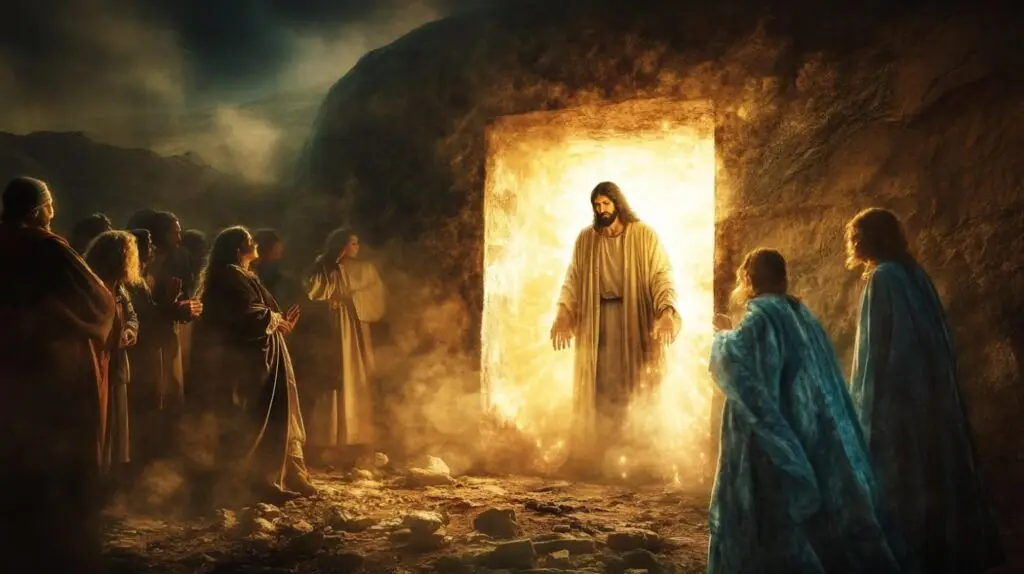Exploring the Meaning Behind One of Jesus’ Most Profound Declarations from Both the Bible and The Urantia Book
“I am the resurrection and the life.
He who believes in me, though he dies, yet shall he live.
And whosoever lives and believes in me shall never die.”
– Jesus of Nazareth (John 11:25–26)
These words, spoken by Jesus at the tomb of Lazarus, have echoed through centuries of Christian tradition as both a promise and a proclamation. But what did he really mean? Was he pointing to a miraculous resurrection event, a spiritual principle, or something more eternal?
Let’s take a closer look at this statement from two lenses — the traditional biblical interpretation and the expanded vision offered by The Urantia Book.
📖 The Biblical View: Hope Through Faith
In the Gospel of John, Jesus speaks these words to Martha, the sister of Lazarus, just before performing one of his most dramatic miracles — raising Lazarus from the dead.
From a biblical perspective, this moment is a pivotal declaration of Jesus’ divinity and power over death. He is not merely saying he will bring about resurrection — he is identifying himself as the very source of eternal life.
✝️ To believe in Jesus, according to traditional Christianity, is to enter into a relationship that conquers the finality of physical death.
Through faith, believers receive the gift of eternal life, not just in some future paradise, but as a spiritual reality beginning now.
Many Christian interpretations emphasize that:
- “Though he dies” refers to physical death, which is inevitable.
- “Yet shall he live” affirms the promise of bodily resurrection at the end of time.
- “Shall never die” speaks to spiritual immortality — the soul of a believer is safe with God.
In this light, Jesus’ statement becomes the cornerstone of Christian eschatology — the study of the end times and the life beyond.
📘 The Urantia Book View: A Broader Cosmic Truth
The Urantia Book, while affirming the truth of Jesus’ divine identity, offers a wider and deeper view of resurrection and eternal life.
In Paper 168 of The Urantia Book, this same scene is portrayed in similar language, with this moment emphasized not only as a reassurance to Martha but as a revelatory teaching for all humankind:
“I am the resurrection and the life. He who believes this truth, though he dies, shall live again. Everyone who lives the truth and believes in the light shall never die in spirit. Do you believe this, Martha?” — [UB 168:1.13 (1844.5)]
Where the Bible focuses on faith in Jesus himself, the Urantia Book expands that meaning to include faith in the truth he embodied — the truth of the Father’s love, the reality of the soul’s survival, and the eternal journey of spiritual ascent.
🔹 Key differences in Urantia interpretation:
- Death is not a punishment or the end, but a transition.
- Resurrection is a universal reality for all evolving mortals — an awakening on the “mansion worlds.”
- To “live and believe” means to live a truth-filled life and trust in the spiritual reality of divine sonship.
Rather than positioning salvation as dependent on religious belief alone, The Urantia Book emphasizes a living faith in God — demonstrated through spiritual growth, service, and love.
🌱 One Truth, Two Expressions
At the heart of both teachings is the assurance that death is not the end. Whether through traditional Christian belief in the redemptive work of Jesus or the Urantia revelation of an eternal spiritual career, the message is clear:
✨ Life continues.
Love endures.
And the soul lives on.
💬 A Personal Reflection
When Jesus said, “I am the resurrection and the life,” he wasn’t just offering comfort to grieving friends. He was declaring a timeless truth — that the spark of divine life within us is meant to evolve, ascend, and awaken.
We are not merely bodies; we are souls.
And those who live in truth, love, and faith never really die.
🙏 Affirmation
“I believe in the eternal reality of life.
I trust the spirit within me is deathless.
As I live the truth, I grow closer to the Source of all life.”

